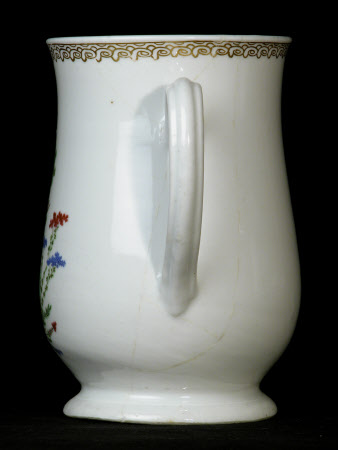Mug
Plymouth Porcelain Factory
Category
Ceramics
Date
1769 - 1770
Materials
hard paste porcelain
Measurements
160 mm (Height); 107 mm (Diameter); 90 mm (Diameter)
Place of origin
Plymouth
Order this imageCollection
Saltram, Devon
NT 870974
Caption
The collection you can see at Saltram today was built up by many generations of the Parker family. Items were bought, sold or added to from other houses belonging to the family. Many of the English ceramics came to Saltram in the 19th century, acquired by Edmund Henry Parker (1810-1864), 2nd Earl of Morley. Edmund took a specialist approach to collecting ceramics, enabling him to demonstrate his knowledge and taste amongst other wealthy elites. In the 19th century, Plymouth porcelain was highly collectable on account of its prestigious claim to being the first ‘true’ porcelain produced in England. Edmund had a large collection of Plymouth porcelain which he kept on display at Kent house, his property in Knightsbridge. Edmund felt his collection sufficiently important to donate some of it to the Museum of Practical Geology (now the Victorian & Albert Museum). His donation included a Plymouth porcelain mug decorated with exotic birds, very similar to this one.
Summary
Baluster shaped mug with handle made at the Plymouth Porcelain factory 1768-1770. Hand thrown in hard paste porcelain and hand painted in polychrome enamel and gilding. Decorated with three exotic birds against a green landscape. The rim is gilded in a geometric pattern. The Saltram Collection (1967): No 281, p.62
Full description
This mug was produced at the Plymouth porcelain factory. In its first year, the factory almost entirely produced blue and white decoration. As the potters developed experience of firing its new material, they also started to introduce pieces hand painted in coloured enamels on top of the glaze. This coincided with the arrival of a workman from France, often referred to as ‘Mon Soqui’. Soqui appears to have brought with him recipes for coloured glazes and techniques, for painting, possibly from the French factory of Sevres. At this time, tablewares including mugs such as this one, were produced with exotic bird decoration. These birds are often attributed to the painter Soqui. The Plymouth Porcelain factory was established by William Cookworthy (1705-1780) in 1768. It was the first to produce so-called ‘hard paste’, or ‘true’ porcelain in the UK. This meant that it combined the materials of china clay (kaolin) and china stone (petunse) to produce a hard-fired body to the same recipe as Chinese porcelain. Many European factories attempted to re-create Chinese porcelain which was famed for its translucency and much in demand. The recipe for porcelain was a closely guarded secret. Only a handful of factories managed to re-create it, the first being Meissen in Germany in 1708. Cookworthy was a chemist based in Plymouth who experimented with the china clay he found in Cornwall. Tests and trial firings went on for over 20 years before he was finally able to establish industrial production in Plymouth in 1768. The factory produced a range of domestic and decorative wares in blue and white and in polychrome enamels. However, the factory was beset with manufacturing problems. Impurities in the materials, challenges with firing the kiln, and potters inexperienced in working with the new material meant that the quality of porcelain was extremely varied. The factory only ran for two years before it transferred to Bristol under the management of Richard Champion (1743-1791) in 1770. At Saltram, there is no evidence that the Parker family acquired Plymouth porcelain directly from Cookworthy and the factory. At that time, they were busy purchasing some of the finest ceramics that money could buy. The lower quality of Plymouth porcelain may well have been unappealing. Plymouth porcelain saw a rise in popularity in the later 19th century, when collectors realised its cultural value as the first UK factory. Many of the Plymouth pieces at Saltram today were acquired either by Edmund Henry Parker (1810-1864), 2nd Earl of Morley who kept a large porcelain collection at his London residence, Kent House in Knightsbridge. Or by his brother in law, Montagu Edmund Newcome Parker (1807-1858) who also amassed a substantial collection of ceramics. Both men donated part of their collection, including items of Plymouth porcelain, to the Museum of Practical Geology (now the Victoria and Albert museum), London.
Provenance
Possibly acquired by Montagu Edmund Newcome Parker (1807-1858) or Edmund Parker (1810-1864), 2nd Earl of Morley and by descent to Edmund Robert Parker (1878-1951), 4th Earl of Morley and accepted in lieu of payment of Estate Duty and transferred to NT in 1957.
Makers and roles
Plymouth Porcelain Factory, manufacturer
References
National Trust (Great Britain), The Saltram Collection., 1967, No. 281, p.62.

